1994 CHEVROLET SUBURBAN check engine
[x] Cancel search: check enginePage 343 of 385

GASOLINE ENGINES WITH HEAVY DUTY EMISSIONS
- MAINTENANCE SCHEDULE yf
Item Miles (000) 3
No. Kilometers (000) 5 Service
I
1 Engine Oil Change*-Every 3 Months, or t
Oil Filter Change*-Every 3 Months, or t
12 Chassis Lubrication-Every 12 Months, or I+
II
3 Clutch Fork Ball Stud Lubrication (5-speed manual
transmission with deeplow only)
Cooling System Service*-Every 24 Months or
Air Cleaner Filter Replacement* Front Wheel Bearing Repack
Transmission Service
**
Fuel Filter Replacement*
10
11
12
13
14
15
16
17
18
I9
Spark Plugs Replacement*
Spark Plug Wire Inspection*
EGR System Inspection*
Electronic Vacuum Regulator Valve (EVRV)
Inspection*
Engine Timing Checkk
Fuel Tank, Cap and Lines Inspection
*
Thermostatically Controlled Air Cleaner
Inspectionk
Engine Accessory Drive (Serpentine) Belt
Inspection*
Evaporative Control System Inspection*
Shields and Underhood Insulation InspectionA.
20
21
-
23
24
-
Air Intake System InspectionA. I
Brake Systems Inspection** I
* An Emission Control Service
** See “Explanation of Scheduled Maintenance Services” in the Index.
A A Noise Emission Control Service
Applicable only to vehicles sold in the United States
t To determine the emissions classification of your engine, refer to “Selecting the Proper
Maintenance Chart” in this section.
TO404
7-10
ProCarManuals.com
Page 347 of 385
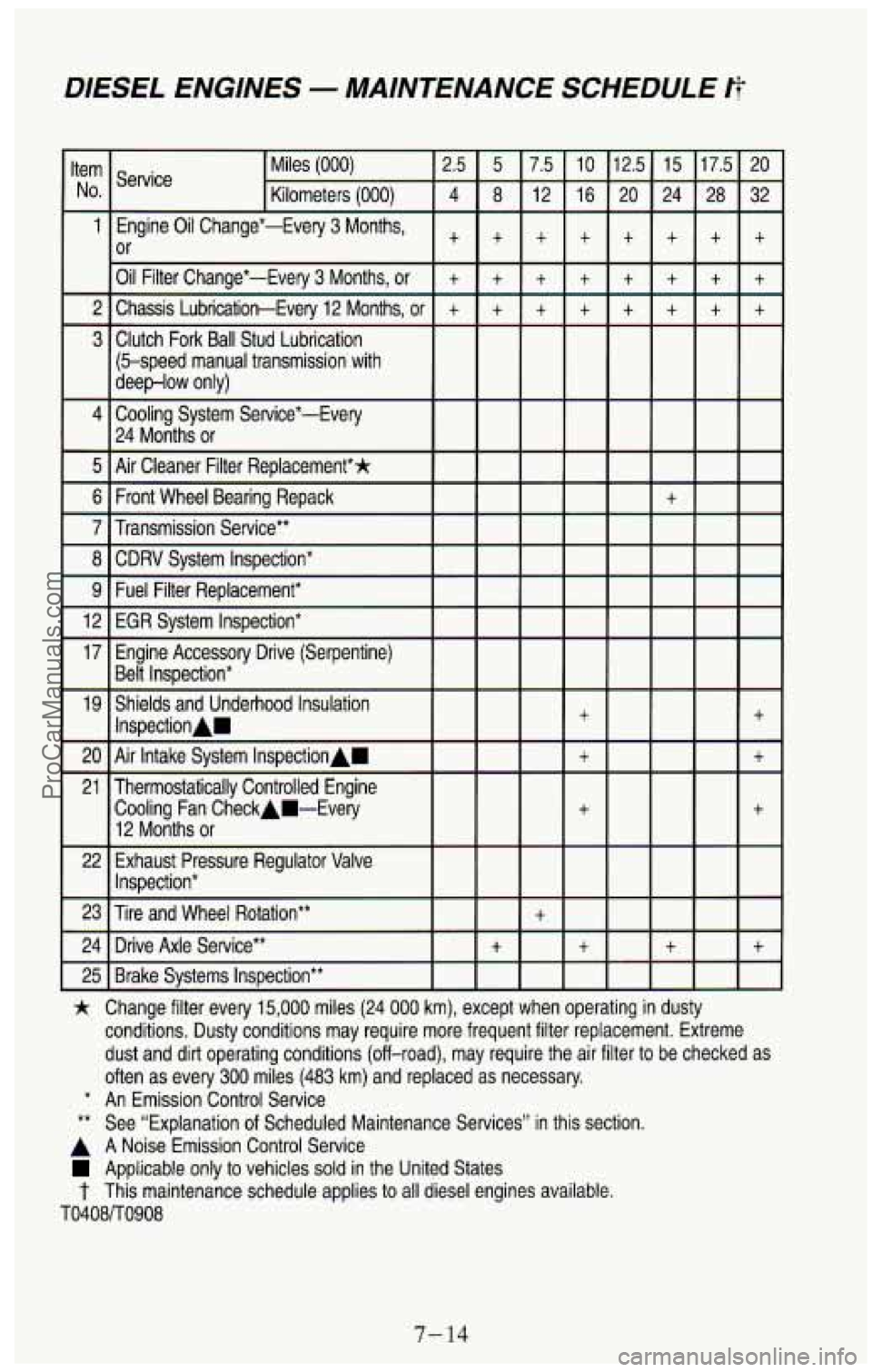
DIESEL ENGINES - MAINTENANCE SCHEDULE fi
* Change filter every 15,000 miles (24 000 km), except when operating i
conditions. Dusty conditions may require more frequent filter re\
placem
dust and
dirt operating conditions (off-road), may require the air filter tl
often as every 300 miles (483 km) and replaced as necessary.
* An Emission Control Service
** See “Explanation of Scheduled Maintenance Services” in this section.
A A Noise Emission Control Service
Applicable only to vehicles sold in the United States
t This maintenance schedule applies to all diesel engines available.
T0408D0908
I dusty
nt. Extreme
1 be checked as
7- 14
ProCarManuals.com
Page 349 of 385
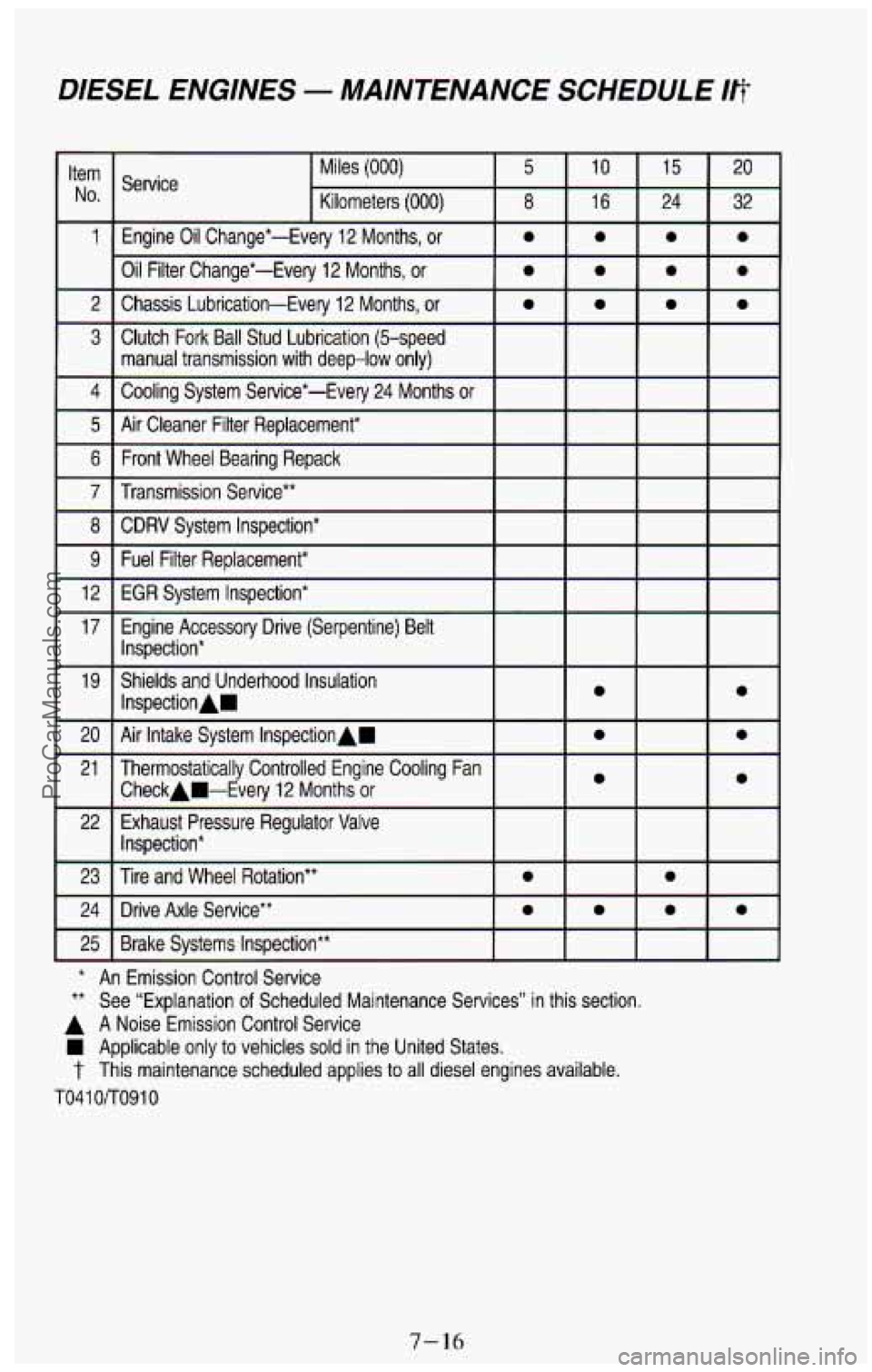
DlES€L ENGINES - MAINTENANCE SCHEDULE Ifi
Item
No.
1
-
8 CDRV System Inspection*
9 Fuel Filter Replacement*
12 EGR System Inspection*
17 Engine Accessory Drive (Serpentine) Belt Inspection*
19 Shields and Underhood Insulation
20 Air Intake System InspectionAD
0 0
InspectionAH 0 0
21 Thermostatically Controlled Engine Cooling Fan 0 0
CheckAH-Every 12 Months or
22 Exhaust Pressure Regulator Valve
Inspection*
23 Tire and Wheel Rotation**
0 0
24 Drive Axle Service** 0 0 0 0
25 Brake Systems Inspection**
* An Emission Control Service
** See “Explanation of Scheduled Maintenance Services” in this section,
A A Noise Emission Control Service
H Applicable only to vehicles sold in the United States.
t This maintenance scheduled applies to all diesel engines available.
TO4
1 Oflo91 0
7-16
ProCarManuals.com
Page 351 of 385
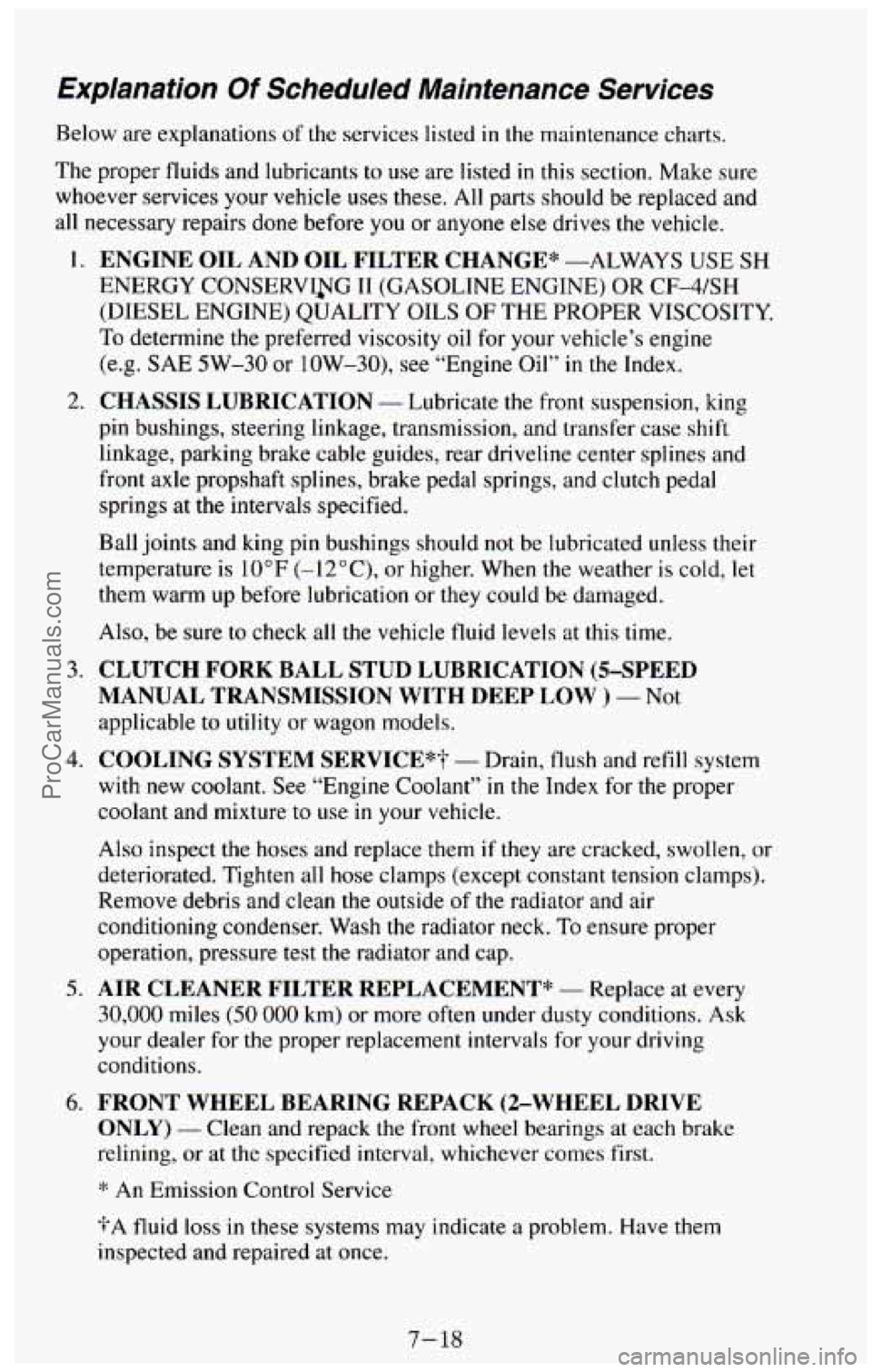
Explanation Of Scheduled Maintenance Services
Below are explanations of the services listed in the maintenance charts.
The proper fluids and lubricants to
use are listed in this section. Make sure
whoever services your vehicle uses these.
All parts should be replaced and
all necessary repairs done before you or anyone else drives the vehicle.
1. ENGINE OIL AND OIL FILTER CHANGE* -ALWAYS USE SH
ENERGY CONSERVIJTG TI (GASOLINE ENGINE) OR CF-4/SH
(DIESEL ENGINE) QUALITY OILS OF THE PROPER VISCOSITY.
To determine the preferred viscosity oil for your vehicle’s engine
(e.g.
SAE 5W-30 or low-30), see “Engine Oil” in the Index.
2. CHASSIS LUBRICATION - Lubricate the front suspension, king
pin bushings, steering linkage, transmission, and transfer case shift
linkage, parking brake cable guides, rear driveline center splines and
front axle propshaft splines, brake pedal springs, and clutch pedal
springs at the intervals specified.
Ball joints and king pin bushings should not be lubricated unless their
temperature is
10°F (-12”C), or higher. When the weather is cold, let
them warm up before lubrication or they could be damaged.
Also, be sure to check all the vehicle fluid levels at this time.
3. CLUTCH FORK BALL STUD LUBRICATION (5-SPEED
MANUAL TRANSMISSION
WITH DEEP LOW ) - Not
applicable to utility or wagon models.
4. COOLING SYSTEM SERVICE*? - Drain, flush and refill system
with new coolant. See “Engine Coolant’’
in the Index for the proper
coolant and mixture to use
in your vehicle.
Also inspect the hoses and replace them
if they are cracked, swollen, or
deteriorated. Tighten all
hose clamps (except constant tension clamps).
Remove debris and clean
the outside of the radiator and air
conditioning condenser. Wash the radiator
neck. To ensure proper
operation, pressure test the radiator and cap.
5. AIR CLEANER FILTER REPLACEMENT* - Replace at every
30,000 miles (50 000 km) or more often under dusty conditions. Ask
your dealer for the proper replacement intervals
for your driving
conditions.
6. FRONT WHEEL BEARING REPACK (2-WHEEL DRIVE
ONLY)
- Clean and repack the front wheel bearings at each brake
relining, or at the specified interval, whichever comes first.
4’ An Emission Control Service
*A fluid loss in these systems may indicate a problem. Have them
inspected and repaired at once.
7- 18
ProCarManuals.com
Page 353 of 385

12.
13.
14.
15.
16.
17.
18.
19.
20.
EGR SYSTEM INSPECTION* - Conduct EGR SYSTEM CHECK
as described in the Service Manual.
ELECTRONIC VACUUM REGULATOR VALVE (EVRV)
INSPECTION*
- Inspect filter for excessive contamination or
plugging. If required, clean element with a solution of biodegradable
soap and water, let dry and reinstall element.
ENGINE TIMING CHECK AND DISTRIBUTOR CHECK (SOME
MODELS)*$
- Adjust timing to underhood label specifications.
Inspect
the inside and outside of the distributor cap and rotor for cracks,
carbon tracking and corrosion. Clean
or replace as needed,
FUEL TANK, CAP AND LINES INSPECTION*$ - Inspect the
fuel tank, cap and lines for damage or leaks. Remove fuel cap, inspect
gasket for an even filler neck imprint, and any damage. Replace parts
as needed.
THERMOSTATICALLY CONTROLLED AIR CLEANER
INSPECTION*A
- (If so equipped.) Inspect all hoses and ducts for
proper hook-up.
Be sure the valve works properly.
SINGLE ENGINE ACCESSORY DRIVE (SERPENTINE) BELT
INSPECTION*
- Inspect belt. Look for cracks, fraying, wear, and
proper tension. Adjust or replace
as needed.
Check all
fuel and vapor lines and hoses for proper hookup, routing,
and condition. Check that the purge valve works properly,
if equipped.
Replace as needed.
SHIELDS AND UNDERHOOD INSULATION INSPECTIONAV
- Inspect shields and underhood insulation for damage or looseness.
Adjust or replace
as required.
AIR INTAKE SYSTEM INSPECTIONAV - Check the air intake
system installation to see that gaskets are sealed properly and all hose
connections, fasteners, and other components are tight. Also check to
be sure that
the air cleaner housing is properly seated, that the cover fits
tightly, and the wing nuts are tight. Tighten connections and fasteners
or replace damaged parts
as required.
'% An Emission Control Service
ANoise Emission Control Service
P'Applicable only to vehicles sold
in the United States
$The California Air Resources Board
has determined that the failure to
perform this maintenance item will not nullify
the emission warranty or
limit recall liability prior to the completion of the vehicle \
useful life.
General Motors, however, urges that
all recommended maintenance
services be performed at the indicated intervals and the maintenance be \
recorded.
EVAPORATIVE CONTROL SYSTEM (ECS) INSPECTION* -
7-20
ProCarManuals.com
Page 354 of 385

2 I. THERMOSTATICALLY CONTROLLED ENGINE COOLING FAN INSPECTIONAI/
- (If so equipped.) Inspect all hoses and
ducts for proper hook-up. Be sure the valve works properly.
22. EXHAUST PRESSURE REGULATOR VALVE INSPECTION” -
Check that the valve works properly, Correct any binding. Inspect
hoses for cracks, chafing or decay. Replace parts as needed.
23. TIRE AND WHEEL ROTATION AND INSPECTION - For proper
wear and maximum tire life, rotate tires at the first 6,000 miles
(10 000
kilometers) for Schedule
I (+) or 7,500 miles (12 500 kilometers) for
Schedule
I1 (0) and then every 15,000 miles (25 000 kilometers)
thereafter. Follow the instructions and patterns shown
in Section 6.
Check tires for uneven wear or damage. If irregular or premature wear is
apparent, check wheel alignment. Also, check or damaged wheels. See
“Tires”
in the Index for more information.
For dual wheels, whenever the vehicle, wheels, or fasteners are new,
have the wheel fastener torque
set at the first 100, 1,000 and 6,000 miles
( 160, 1600 and 10 000 km).
Block the tires opposite
those being removed to keep the vehicle from
rolling.
24.
DRIVE AXLE SERVICE? - Check readfront axle fluid level and
add
as needed. Check constant velocity joints and axle seals for
leaking.
0 Locking differential - Drain fluid at first oil change and refill.
Check fluid
level and add as needed at subsequent oil changes. In
dusty areas, or trailer towing applications drain fluid at every
15,000 miles (24 135 kilometers) and refill.
Standard differential - Check fluid level and add as needed at
every oil change. In dusty areas, or trailer towing applications,
drain fluid every
15,000 miles (24 135 kilometers) and refill.
0 More frequent lubrication may be required on heavy-duty or
off-road
use.
:i: An Emission Control Service
ANoise Emission Control Service
VApplicable
only to vehicles sold in the United States
+A fluid
loss in these systems may indicate a problem. Have them
inspected and repaired
at once.
7-21 ProCarManuals.com
Page 355 of 385
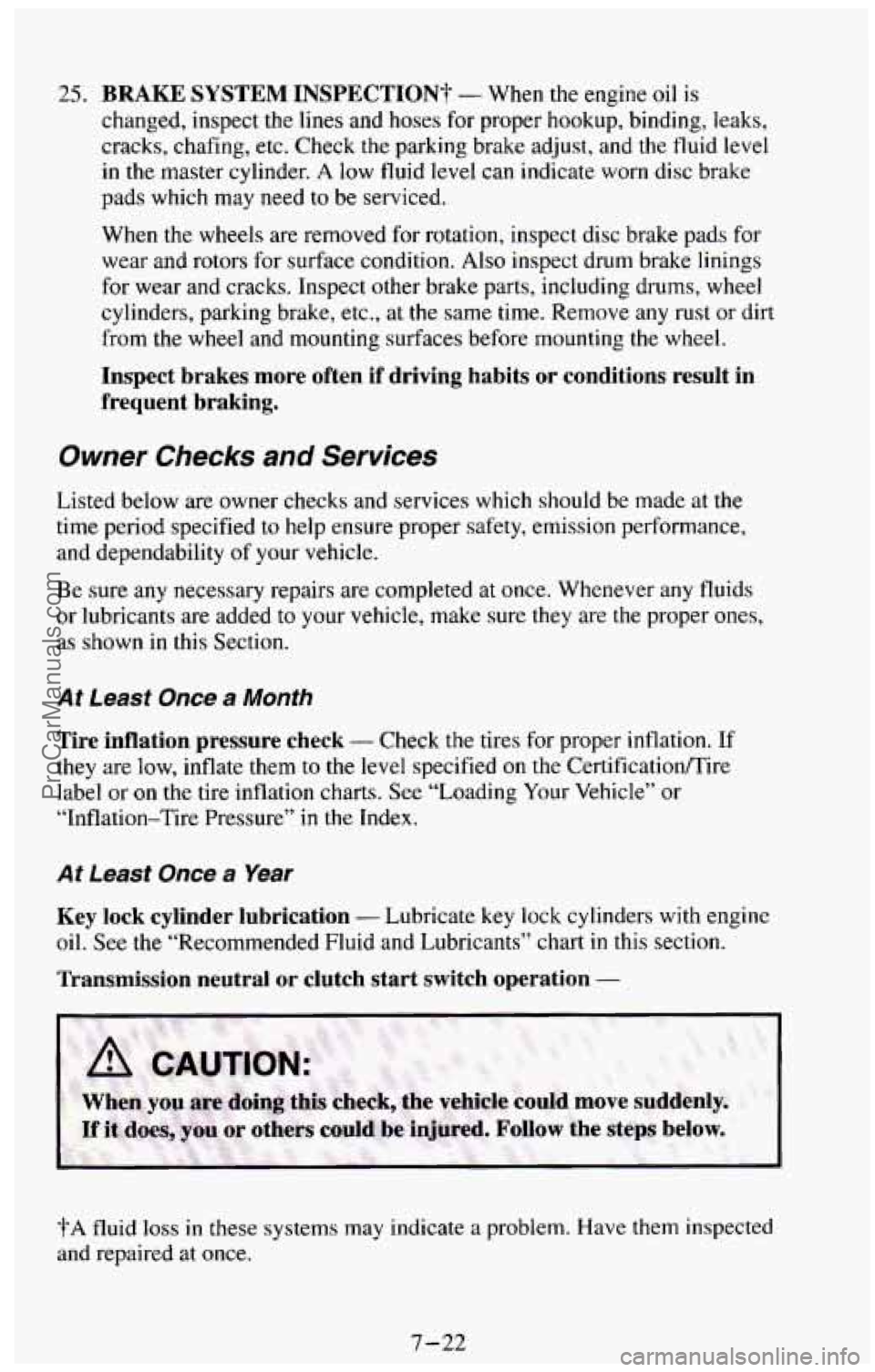
25. BRAKE SYSTEM INSPECTION? - When the engine oil is
changed, inspect the
lines and hoses for proper hookup, binding, leaks,
cracks, chafing, etc. Check
the parking brake adjust, and the fluid level
in the master cylinder.
A low fluid level can indicate worn disc brake
pads which may need to be serviced.
When the wheels are removed for rotation, inspect disc brake pads for
wear and rotors for surface condition. Also inspect drum brake linings
for wear and cracks. Inspect other brake parts, including drums, wheel
cylinders, parking brake, etc., at
the same time. Remove any rust or dirt
from the wheel and mounting surfaces before mounting
the wheel.
Inspect brakes more often if driving habits or conditions resul\
t in
frequent braking.
Owner Checks and Services
Listed below are owner checks and services which should be made at the
time period specified to help ensure proper safety, emission performance,
and dependability of your vehicle.
Be
sure any necessary repairs are completed at once. Whenever any fluids
or lubricants
are added to your vehicle, make sure they are the proper ones,
as shown in this Section.
At Least Once a Month
Tire inflation pressure check - Check the tires for proper inflation. If
they are low, inflate them to the level specified on the Certificatiomire
label or on the tire inflation charts. See “Loading Your Vehicle” or
“Inflation-Tire Pressure”
in the Index.
At Least Once a Year
Key lock cylinder lubrication - Lubricate key lock cylinders with engine
oil. See the “Recommended Fluid and Lubricants” chart
in this section.
Transmission neutral or clutch start switch operation -
?A fluid loss in these systems may indicate a problem. Have them inspected
and repaired at once.
7-22
ProCarManuals.com
Page 356 of 385
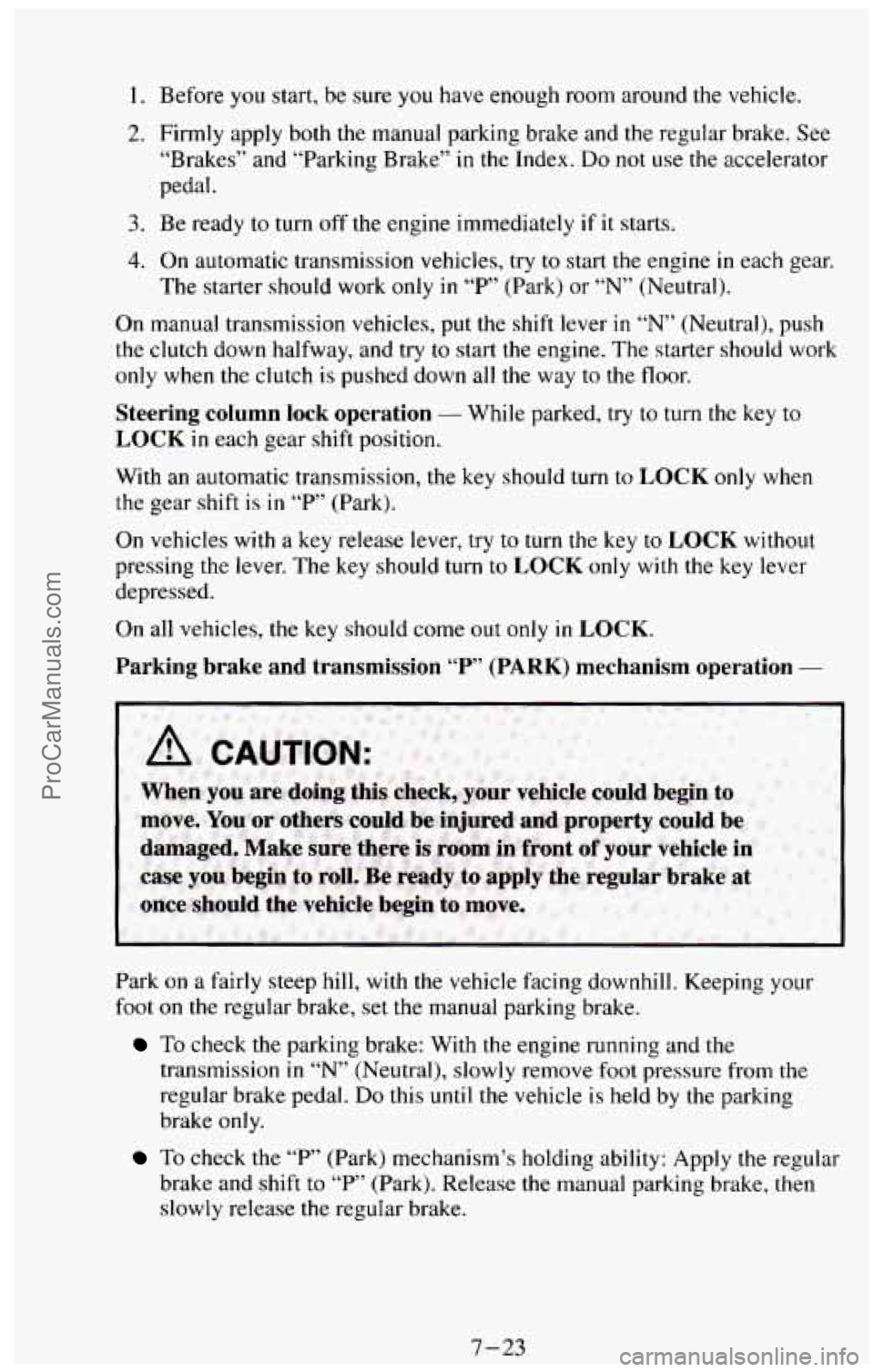
I. Before you start, be sure you have enough room around the vehicle.
2. Firmly apply both the manual parking brake and the Ye‘@lar brake. See
“Brakes” and “Parking Brake” in the Index.
Do not use the accelerator
pedal.
3. Be ready to turn off the engine immediately if it starts.
4. On automatic transmission vehicles, try to start the engine in each gear.
The starter should work only in
“P’ (Park) or “N” (Neutral).
On manual transmission vehicles, put the shift lever
in “N” (Neutral), push
the clutch down halfway, and try to start the engine. The starter should work
only when the clutch is pushed down all the way to the floor.
Steering column lock operation - While parked, try to turn the key to
LOCK in each gear shift position.
With an automatic transmission, the key should turn to
LOCK only when
the gear shift is in
“P” (Park).
On vehicles with a key release lever, try to turn the key to LOCK without
pressing the lever. The key should turn to
LOCK only with the key lever
depressed.
On all vehicles, the key should come out only in
LOCK.
Parking brake and transmission
“P’ (PARK) mechanism operation -
Park on a fairly steep hill, with the vehicle facing downhill. Keeping your
foot
on the regular brake, set the manual parking brake.
To check the parking brake: With the engine running and the
transmission in
“N” (Neutral), slowly remove foot pressure from the
regular brake pedal.
Do this until the vehicle is held by the parking
brake
only.
To check the “P” (Park) mechanism’s holding ability: Apply the regular
brake and shift to
“P’ (Park). Release the manual parking brake, then
slowly release the regular brake.
7-23 ProCarManuals.com